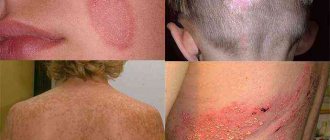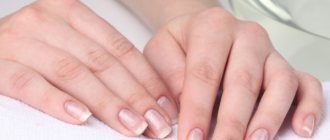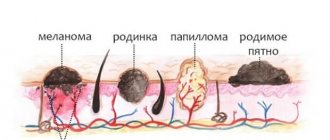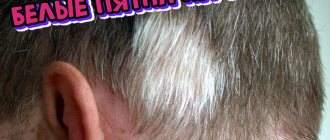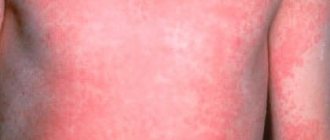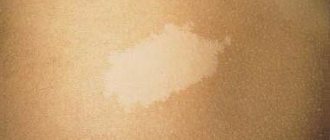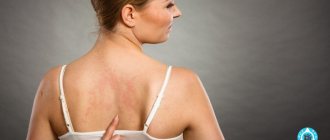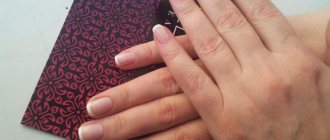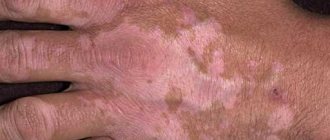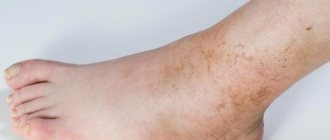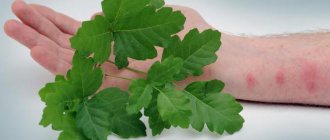( 1 ratings, average: 5.00 out of 5)
Home » Skin spots
Ringworm is a common skin lesion. It is usually caused by a fungal or viral infection. When a person develops spots on the skin similar to lichen, it is necessary to visit a dermatologist’s office.
The resulting skin defect can be a manifestation of numerous diseases, ranging from allergies to fungal infections. Therefore, it is so important to consult a doctor who will determine the exact cause and prescribe a treatment regimen. Let's consider the most common causes of this phenomenon, photos of diseases, methods of treatment and methods of prevention.
How does lichen manifest itself?
In case of multiple skin rashes, it is necessary to diagnose the disease according to the list of symptoms:
- Pityriasis rosea most often occurs due to a virus or as a result of an allergy. The spots on the skin are round and flaky in the center; there may be a red rim around the perimeter. The pain is not very pronounced.
- Ringworm occurs due to fungal infection from animals and sick people. Spots can appear not only on the body, but also on the head.
- Herpes zoster develops after infection by the herpes virus. Most often, spots form in the ribs or nearby areas of the skin. If a person did not have chickenpox as a child, then there is a high risk of contracting herpes zoster in adulthood.
- A virus or an allergic reaction can trigger the development of lichen planus. Rashes appear all over the body. You may notice small bright red nodular spots on the skin, which eventually develop into plaques.
- Tinea versicolor spreads throughout the body due to a fungal infection. Yellow or brownish rashes may be seen on the skin. They gradually increase in size and merge into one large brown-brown spot.
- Lichen alba most often occurs in a chronic form. Relapse of the disease occurs even with strong immunity. Characteristic signs of pathology include whitish rashes that do not have clear boundaries. Sometimes inflammation can be a concern.
In all cases, the following symptoms should alert a person:
- itchy skin,
- peeling of the skin,
- pigmentation of the affected area,
- darkening or lightening of the spot,
- the presence of pink, red or brown spots,
- in some cases there may be nodules and blisters.
If the structure of the skin is damaged, the risk of infection increases, so you need to treat the affected areas with special products.
How to treat with folk remedies
If a person has any spots on his body, he immediately panics, realizing that it is lichen. Especially if these spots quickly spread throughout the body.
Let us tell you the recipes for several of these remedies:
- The most common folk recipe for skin stains is bird droppings. Although this may seem strange at first glance, it is an effective method. Bird droppings contain many granules of mineral compounds that can improve regeneration itself. It’s easier to say - it’s the same thing as improving immunity, only with a completely different method.
- Birch tar, ordinary tar soap, and mumiyo can help with this problem. These products can be purchased at any pharmacy at a low price, but the results from them are exactly the same as from more expensive drugs. The effect of birch tar and mumiyo is the same as that of bird droppings. They contain many useful substances that help restore the damaged protective layer of the skin.
- This simple ointment, which can be prepared at home, will help you remove stains on the skin perfectly: squeeze 2 cloves of garlic through a garlic press, mix it with 1 tbsp. A spoonful of lemon juice. The process of action is as follows: the acid has a bad effect on spores that have spread over the skin, although it does not destroy them at all. It would be more correct to say that this recipe is best used as a simple addition to folk remedies for spots on the body.
Source: FeedMed.ru
The name "lichen" is a collective name
Some people are more susceptible to fungal infections, while others do not become infected even through close household and sexual contact with patients or carriers. The appearance of spots on the skin, similar to lichen, usually causes alarm among those who have at least once encountered fungal diseases.
Many people know that the causative agents of ringworm are transmitted from a sick person or animal. Characteristic signs of a contagious infection are ring spots, round plaques on the head, limbs and torso. Peeling of the skin occurs on the affected area of the skin, and severe or moderate itching occurs.
Spots on the skin similar to lichen occur with the following diseases:
- Trichophytosis of the skin of the body and head (cause: fungal infection).
- Versicolor or pityriasis versicolor (caused by several types of fungi).
- Mycotic and microbial eczema (caused by fungal and bacterial infection).
- Lichen planus (causes: viral infection, allergic reactions).
- Shingles or herpes zoster (caused by a herpes virus).
- Pityriasis rosea (the causative agent is a virus, the causes are associated with allergies).
- Psoriasis, scab or lichen planus (autoimmune disease).
- Microsporia or ringworm (caused by a fungal infection).
It happens that the fungus - the causative agent of trichophytosis - is present and does not manifest itself in any way; it is suppressed by the immune system. The same thing happens with shingles. This is a herpes virus infection, its causative agent is varicella zoster. It causes chickenpox in childhood and persists in the nerve endings of people who have had chickenpox. Under certain conditions, the varicella zoster virus becomes active again and causes shingles. The disease is sometimes very difficult, the temperature rises, and severe pain appears in the chest area.
Anaphylactic shock after a wasp or hornet sting. What to do?
As already mentioned, anaphylactic shock is the most dangerous consequence of an insect bite. According to statistics, it is most often provoked by medications, followed by food allergens (honey, peanuts, seafood, etc.). However, a certain percentage of cases also involve insect bites.
The greatest likelihood of getting anaphylactic shock is from the bites of wasps and hornets, since they can inject poison repeatedly. In addition, it is much stronger than that of bees. The most typical manifestations of anaphylactic shock:
Drop in blood pressure;
Bronchial spasm and suffocation.
However, it can all start as a typical allergic reaction:
skin redness and rashes;
cough, nasal congestion and sneezing;
weakness and dizziness;
swelling of the eyelids and lips.
Further symptoms develop rapidly: it becomes difficult for the person to inhale and exhale, and he loses consciousness.
move the victim to the shade and provide fresh air;
remove outer clothing, lay on side;
apply a tourniquet above the bite site, cool the bite site with ice or cold water. The tourniquet can be applied for no more than 25 minutes, periodically loosen it and move it higher or lower;
urgently administer epinephrine (adrenaline) intramuscularly. Always keep a syringe tube with the drug in your first aid kit if you live outside the city! If bronchospasm does not go away after 15 minutes, the drug should be re-administered. You can inject into any muscle;
IMPORTANT! If the attack is controlled, the victim still needs hospitalization. According to statistics, in one out of five cases, anaphylactic shock develops in two stages. The second attack can occur 6 to 12 hours after the first, so the victim should be under medical supervision.
Diseases similar to lichen in symptoms
In some situations, allergic eczema can be confused with lichen. In the first case, red and pink spots also form on the skin, which swell and itch. These two diseases can be distinguished by the condition of the rash after scratching:
- scratching the lichen will be accompanied by peeling,
- If you scratch the eczema, an erosive formation will appear in its place.
Dermatitis can occur in different forms, which are sometimes mistakenly perceived as lichen. Symptoms of such skin damage also include inflammation and swelling of the skin, but, compared to lichen, the boundaries of the spots are clear.
Based on the symptoms of psoriasis, a diagnosis of lichen planus can be made. Indurations are noticeable on the skin, which soon become large plaques.
Some features of the body manifest themselves as hyperpigmentation of the skin, which can develop on any part of the body. To exclude this diagnosis, the doctor prescribes a hormonal test. A distinctive feature of lichen is the formation of multiple spots of different sizes and shades.
Diagnostic methods
To determine the type of skin rash, you need to see a dermatologist or venereologist. If necessary, the doctor can prescribe a consultation with specialists in a public or private clinic.
In addition to a visual examination, additional studies may be prescribed, for example:
- blood test (if there is a suspicion of lichen planus),
- microscopic examination of the rash,
- serological study,
- Wood's lamp examination
- Baltsev's test using iodine.
Treatment
- For allergic eczema, doctors prescribe complex treatment. It includes: antihistamines, anti-inflammatory drugs, hormonal ointments, creams that promote skin regeneration. If necessary, antibiotics and vitamins.
- Treatment of psoriasis depends on the general condition of the patient. Hormonal or non-hormonal ointments, antihistamines, vitamins and immunomodulators are used.
- For dermatitis, you need to take anti-allergenic drugs: Zodak, Zyrtec, Suprastin. The course is 5-14 days. Additionally, doctors may prescribe local ointments or creams.
- Treatment for lichen depends on what microorganisms caused its appearance. For a virus, antiviral drugs are prescribed, for fungi, antimycotic drugs, and for bacterial cases, antibiotics.
Allergies and ringworm
Every fourth person experiences allergic reactions to the skin. The manifestations of this condition are similar to lichen, so it is difficult to make a diagnosis on your own.
Despite this, we can make assumptions based on the following characteristics:
- the edges of the lichen spots are clear,
- an allergic reaction occurs upon contact with an allergen and can occur periodically,
- against the background of certain types of lichen, dense scales are formed, reminiscent of seborrheic dermatitis. In other cases, no skin separation is observed.
An allergic reaction or skin irritation occurs quickly, just a couple of hours after contact with the allergen is enough. The irritants most often are food, medicine or household chemicals. Regardless of the type of allergen, nodular or blistering formations appear on the skin. They do not have clear boundaries, and there is inflammation, redness and swelling around the rash.
Ringworm develops and appears on the skin gradually. If a fungal infection occurs, symptoms will be noticeable after 5-7 days. A small spot increases in size over time. This condition is accompanied by discomfort, peeling and itching. The development of atopic dermatitis is also accompanied by the formation of red spots.
If such formations appear on the body, then you should consult a dermatologist. After carrying out diagnostic measures, the doctor can make an accurate diagnosis and prescribe the correct treatment.
You need to understand that many dermatological diseases are contagious and develop with decreased immunity.
Possible diseases, but do not deprive
White spots, similar to lichen, appear due to the fact that the amount of melanin in the skin decreases.
Reasons for their appearance:
- Internal:
- Autoimmune destruction, that is, when the body kills melanocytes (cells that produce melanin);
- Disease of the liver, kidneys, stomach or intestines;
- Heredity;
- Failure of the hormonal cycle, functions of the hypothalamus and pituitary gland;
- Skin diseases of natural origin;
- Poor functioning of the endocrine system and thyroid gland;
- Complex viral infections;
- Avitaminosis;
- Constant nervous tension and stress.
- External:
- Physical trauma to the skin;
- Severe skin sensitivity to all chlorine-based household detergents;
- Frequent contact with various toxic substances
- Spending a long time in the open sun, frequent tanning.
The formation of white spots may be a consequence of some disease, and only a doctor can recognize this after a full examination and the necessary tests.
If their cause has already been found, then the very first thing to do is treat the disease that caused their appearance. What if white spots similar to lichen appear on the body, you need to go to the hospital.
There the doctor will examine the whole body and, if necessary, refer you to other specialists for examination.
To prevent such spots from appearing, try to spend less time in the open sun (in summer).
Before relaxing in the sun, lubricate your skin with protective creams or lotions.
In summer, you need to drink as much fluid as possible so that your skin does not have time to dry out. Fruit tea or fresh berry compote will help prevent white spots. Introduce more fruits, vegetables, and seafood into your food.
Pay close attention to your skin; if there are any strange formations on it, go to the doctor immediately.
Pityriasis rosea - symptoms and treatment
Classic form of the disease
Symptoms of the classic form of pityriasis rosea are:[4]
- The mother's plaque is a single large flat oval spot, 2 to 5 cm in size, pink or red in color with clear boundaries, covered with thin scales and larger scales along the periphery, which gives it a ring-shaped appearance. The most typical localization is the neck, torso, and less commonly, limbs. It is the initial symptom of the disease.
- “Christmas tree” - rashes in the form of small (from 0.5 to 2 cm) numerous scaly papules and plaques of an oblong oval shape of pink color with a “collar” of gray scales located along the lines of Langer’s skin tension, which gives them when localized in the chest or back area looks like tree branches. This rash occurs several days (less often weeks) after the appearance of the maternal plaque.
- Itching is not a mandatory symptom of the disease and occurs in about a quarter of patients.
Atypical forms of the disease
Atypical variants of pityriasis rosea occur in approximately 20% of cases.[5] The uncharacteristic nature is manifested in the morphology of the elements of the rash, its size and location.[4] Some authors believe that children with atopic dermatitis are more predisposed to atypical variants of pityriasis rosea than adults.
Vesicular pityriasis rosea is a generalized rash of vesicles (vesicles) with a diameter of 2-6 mm, often forming “rosettes” and accompanied by severe itching. It is most common in children and adolescents and can be localized to the scalp, palms, and soles.[6]
Hemorrhagic pityriasis rosea is characterized by a purpuric eruption that occurs on the skin and, quite often, on the oral mucosa.[7]
Urticarial pityriasis rosea presents as blistering lesions, making it similar to hives. This type of disease is accompanied by intense itching.[7]
Papular pityriasis rosea is a rare form of the disease that is more common in young children and pregnant women. It manifests itself as rashes of several small papules measuring 1-2 mm, which may be present along with classic spots and plaques.[8]
Pityriasis rosea, similar to erythema multiforme - with this type of disease, along with the classic symptoms, target-shaped lesions are noted.[9]
Follicular pityriasis rosea is characterized by a rash of follicular papules grouped into round plaques. They often occur alongside classic lesions.[7]
Giant Darier's pityriasis rosea presents as very large plaques ranging from 5 cm to 7 cm, with individual lesions reaching the size of the patient's palm.[11]
Vidal's ring-shaped ring-shaped rosacea is localized primarily in the axillary and groin areas and is characterized by large ring-shaped rashes.[12]
Hypopigmented pityriasis rosea most often occurs in dark-skinned and dark-skinned people and presents as hypopigmented scaly plaques with a typical localization.[7]
Lichen rosea inversus is characterized by rashes in the folds - axillary and groin areas, elbow and popliteal fossae.[3]
Acral rosacea presents as a typical rash on the extremities—the forearm, wrist, palm, calf, and sole.[14]
Unilateral pityriasis rosea is an extremely rare variant that occurs in both children and adults. In this form, the rashes are located on one side of the body.[15]
Blaschkoid pityriasis rosea is characterized by lesions along Blaschko's lines (pattern-shaped pigmentation).[16]
Oral lesions in pityriasis rosea occur in 16% of patients in the form of erosions, bullous or hemorrhagic eruptions, but they are usually asymptomatic.[17]
Asbestos pink lichen is a very rare form of the disease, presented in the form of plaques in the scalp area, covered with thick, dense gray scales. Clinically it mimics pityriasis amiantacea.[18]
Decapitated pityriasis rosea - rashes of only secondary small elements occur without the previous appearance of a maternal plaque. Occurs predominantly in children.[7]
Recurrent pityriasis rosea
Recurrence of pityriasis rosea occurs in 1-3% of patients.[19] Frequent relapses are considered a very rare occurrence. However, there are case reports with more than two episodes. The exact etiology is not known, but a possible cause is the reactivation of herpes viruses (varicella zoster, Epstein-Barr, types six and seven).[20]
What insect bites look like on the human body (photo)
Insects and arthropods can bite or sting. In the first case, they use their oral appendages (chelicerae), injecting poison directly from the mouth. In the second case, the poison comes from a sting on the abdomen.
A small, round, slightly swollen spot. Appears almost immediately after the bite;
The spot turns red and thickens, and begins to itch very much after 5-10 minutes;
Lots of small spots in one area.
The bite is more painful than that of a mosquito;
It looks like a red or white bump in the middle of a red circle;
In some cases, it can provoke tissue swelling - this is how an allergic reaction manifests itself.
They look like clusters of spots, usually in the area of the shins and legs;
In appearance - red tubercles with a red halo, very itchy;
Symptoms begin immediately after the bite.
An accumulation of red rashes in different parts of the body, which is caused by an allergic reaction;
The rash is small in size in the form of red, slightly swollen areas, or dark red lesions;
Bites may appear in one line or be grouped on separate parts of the body - usually not covered by clothing (head, arms, neck, legs);
When scratching, severely itchy blisters or hives appear at the site of the bite.
Head lice, body lice, and pubic lice are different types of parasitic lice that feed on human blood.
Lice bites are very itchy and, when scratched, quickly become covered with scabs;
An adult louse is a gray/brown insect about the size of a sesame seed;
Nits (eggs) and nymphs (young lice) look like small white specks and can easily be confused with dandruff.
Some of the most dangerous insects in Russia are widespread in the middle zone and taiga. The bite itself is painless and unnoticed by the victim - the tick injects an anesthetic.
More often, a tick that has already sucked is found on the body. In shape, it resembles a dense wart or a small bump. Most often they can be found in the soft tissue area: on the thighs, groin, under the armpit or under the shoulder blade.
The bite itself appears as a single, slightly reddened spot that goes away on its own.
The main danger is tick-borne encephalitis and Lyme disease (borreliosis). Both diseases affect the central nervous system and lead to death or severe disability.
The well-known skin disease scabies (acrodermatitis) is the result of the proliferation of small mites Sarcoptes scabiei (itchers) on the body.
It may take four to six weeks for characteristic symptoms to appear. This is due to the fact that the body reacts not to the bites themselves, but to the waste products of the tick colony (eggs, excrement, saliva);
The rash appears as intensely itchy pimples, blisters, or scales;
A characteristic feature is whitish or grayish lines on the skin.
In some cases, emergency care may be required after a spider bite. Although most of the spiders that are found in our forests are harmless, their bites can at most cause inflammation, like after a bee sting.
The most dangerous spider living in Russia is the karakurt. It is found in the southern regions: Krasnodar Territory and Crimea. Karakurt poison is deadly if an antidote is not administered within half an hour.
You should also beware of the South Russian tarantula (mizgir) - this is one of the most dangerous species of wolf spiders. It lives mainly in the south of Ukraine, as well as in the Crimea and Krasnodar region. Tarantula venom is not fatal, but it is extremely painful, causing fever, vomiting, and headache. In some cases, after a tarantula bite, the skin turns yellow and retains this color for two months.
In general, a spider bite appears as two small marks;
The bite site quickly becomes inflamed and red;
An allergic reaction may develop, similar to a hornet sting.
A bee sting causes local inflammation, swelling and severe itching;
A small white spot forms at the puncture site;
The swelling lasts from 3 to 7 days, depending on the person’s immunity to bee venom. Sometimes the tissues do not swell at all - it all depends on the location of the bite;
An allergic reaction in the form of redness of the bite site and increased temperature is possible.
The wasp is an extremely common insect in central Russia. Often makes nests in trees or under the roofs of houses. Ground wasps make their nests in burrows.
Wasp venom is more painful than that of a bee. The victim experiences sharp pain, followed by severe burning and itching;
The wasp is more aggressive and, unlike a bee, can sting several times in a row;
A characteristic white lump (spot) appears at the site of the bite. Tissue swelling develops, which does not subside from 3 to 7 days;
As with the bee, the temperature may rise.
The hornet is the most dangerous among all flying insects. This is nothing more than a type of wasp - the largest among them. The venom is even more painful than that of wasps because it contains acetylcholine, a powerful substance that lowers blood pressure. In addition, a hornet, like a wasp, can inflict several stings in a row.
When bitten, the victim feels a sharp, severe pain;
The bite site swells and a red spot forms around it;
The skin around the bite site is hot to the touch;
With a high concentration of poison, a severe allergic reaction is possible, including anaphylactic shock.
When bitten, swelling develops and severe pain is felt;
The bite site is very itchy;
There is pronounced redness around the bite site, the skin becomes hot to the touch.
The ringed scolopendra, which lives in the Crimea, has a rather painful bite. The poison is not fatal, however, it can cause nausea and vomiting, severe headache, fever and dizziness. Typically, painful symptoms last 1–2 days, after which they disappear completely.
The bite of scolopendra is similar to that of a spider. They look like two red dots in the center of small bumps;
The tissue around the bite becomes inflamed and red.
Symptoms of erythema annulare
The exact cause of this disease is difficult to identify. It is usually chronic. This is a kind of toxic reaction to an allergen or infection.
At the initial stage, spots are noticeable on the body that are visually similar to lichen. They are also itchy and slightly flaky. As they increase, a ring is formed with bright pink borders and a small depression in the center. There is no peeling or pathological coloration in the center of the spot. The size of the formation on the skin can vary between 2-8 cm. The shape is not always round, sometimes the spot resembles a half ring or a garland. In rare cases, due to the disease, mild itching may occur, or spots on the body may not itch at all.
The patient may be offered the following treatment:
- Elimination of chronic foci of inflammation, for example, sinusitis or tonsillitis.
- Improving gastrointestinal functions.
- Taking antiallergic drugs.
- Taking calcium supplements.
- Injections to remove toxins from the body.
- A strict diet that excludes the intake of allergic foods.
- Use of hormonal ointments.
The tactics for eliminating pathology are built after diagnosis and testing.
What causes lichen-like spots?
There are a lot of factors leading to the appearance of hyperemic and hemorrhagic spots, these can be:
- chronic infectious diseases,
- stressful situations,
- weakening of the immune system,
- dermatological diseases,
- allergy,
- avitaminosis.
In appearance, they may resemble one of the varieties of lichen. If the spots cause discomfort (flaking and itching), you should get tested for herpes, as it can cause these symptoms. If the tumors do not itch or cause any discomfort, this is not a reason to stop worrying. You will not be able to determine the cause of the appearance of such spots on your own; you must definitely go to a dermatologist. He will conduct a diagnosis, prescribe tests and, based on their results, determine the diagnosis.
Return to contents
Causes of the disease
The cause of lichen is pathogenic fungi. Sometimes the disease is of viral origin, and the impetus is weak immunity. You need to know what lichen lesions look like at the initial stage in order to consult a doctor in time for help. Skin diseases take a long time to cure, so the chance of recovery will be higher at the initial stage of the disease.
Ringworm is not a disease - it is a complex of diseases caused by various pathogens, under a common name.
Dermatologists believe that people are prone to infection:
- under stress;
- with weakened immunity;
- with a hereditary predisposition;
- taking allergy medications;
- aged from 25 to 70 years;
- those suffering from colds;
- having a violation of internal organs.
What are the long-term consequences of insect bites?
Certain consequences may occur for people whose bodies are weakened by illness or chemotherapy, so trips to nature are not recommended for them. You should also protect infants who do not yet have immunity against bites from mosquitoes and midges (not to mention bees).
The greatest danger in most regions of Russia comes from taiga tick bites. As already mentioned, they are carriers of two serious diseases - Lyme disease and encephalitis. Therefore, after a tick bite, you should immediately go to the clinic for serum, and also undergo a special course of vaccinations if you often travel outdoors or live in rural areas.
